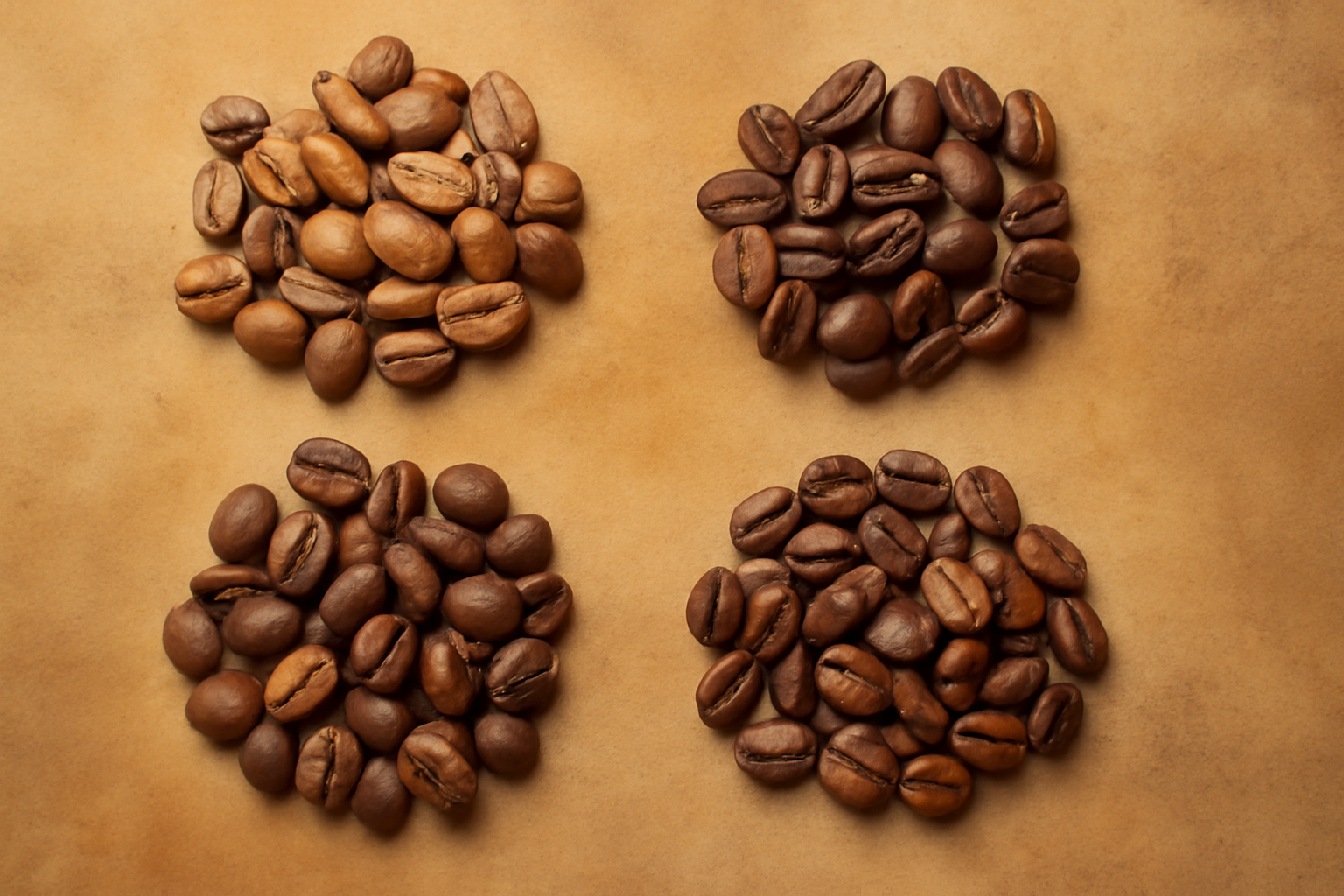Coffee is more than just a morning pick-me-up; it’s a complex beverage with a rich history and a wide variety of flavors. At the core of every great cup of coffee are the coffee beans, which come in different types, each with its own unique flavor profile. As a barista or a coffee enthusiast, understanding the different types of coffee beans and how they affect the brewing process is essential to making the perfect cup.
In this article, we will explore the main types of coffee beans, their characteristics, and how they influence the flavor of your coffee. Whether you’re brewing an espresso, a pour-over, or a French press, the type of coffee bean you choose plays a significant role in the final cup.
1. Arabica Coffee Beans: The Smooth and Flavorful Choice
Arabica beans are the most popular and widely consumed coffee beans in the world, making up about 60-70% of global coffee production. These beans are known for their smooth, mild flavor and bright acidity. They are grown at higher altitudes, typically in regions like Colombia, Ethiopia, and Central America.
Characteristics of Arabica Beans
- Flavor Profile: Arabica beans are known for their balanced and complex flavor profile. They often have fruity, floral, or nutty notes, with a hint of sweetness. Some Arabicas also have chocolatey or caramel-like undertones.
- Acidity: Arabica coffee tends to have a bright acidity, which gives it a lively, refreshing taste. This makes it a popular choice for light to medium roasts.
- Body: Arabica coffee usually has a medium body, making it smooth and easy to drink without being too heavy.
- Bitter Taste: Arabica beans tend to be less bitter than other types of coffee beans, making them more enjoyable for those who prefer a milder cup of coffee.
Best Brewing Methods for Arabica Beans
- Espresso: Arabica beans create a smooth, well-balanced espresso shot with a rich crema. They are perfect for espresso-based drinks like lattes and cappuccinos.
- Pour-Over: The bright acidity and complex flavors of Arabica beans shine when brewed using a pour-over method like the Chemex or V60.
- French Press: Arabica beans brewed in a French press offer a smooth and aromatic cup with a well-rounded flavor profile.
2. Robusta Coffee Beans: The Bold and Strong Option
Robusta beans are the second most popular type of coffee beans, accounting for about 30% of global coffee production. These beans are often seen as the opposite of Arabica beans in terms of flavor, producing a much bolder and more intense cup of coffee. Robusta beans are typically grown at lower altitudes in regions like Vietnam, Indonesia, and parts of Africa.
Characteristics of Robusta Beans
- Flavor Profile: Robusta coffee has a strong, earthy flavor, often described as bitter, woody, or nutty. Some Robusta coffees also have a slight astringency and can taste somewhat harsh compared to Arabica.
- Acidity: Robusta coffee has lower acidity than Arabica, giving it a heavier, more robust taste.
- Body: Robusta beans generally produce a thicker, more full-bodied coffee with a creamy texture.
- Caffeine Content: Robusta beans contain nearly twice the amount of caffeine as Arabica beans, which contributes to their stronger, more intense flavor.
Best Brewing Methods for Robusta Beans
- Espresso: Robusta beans are often used in espresso blends to add strength and a thicker crema. They provide a strong, intense espresso shot with a bold flavor.
- French Press: Brewing Robusta beans in a French press can result in a rich, full-bodied coffee with a more intense flavor profile.
- Italian Coffee: Robusta is a key component in many Italian espresso blends, which are known for their bold and robust taste.
3. Liberica Coffee Beans: The Unique and Smoky Option
Liberica beans are less common than Arabica and Robusta, but they have a distinctive flavor profile that appeals to adventurous coffee drinkers. These beans are grown in regions like the Philippines, Malaysia, and parts of West Africa. They are larger and more irregularly shaped than other types of coffee beans, making them visually unique.
Characteristics of Liberica Beans
- Flavor Profile: Liberica coffee has a complex and bold flavor, with smoky, woody, and fruity notes. It is often described as having a slightly tangy taste, with hints of dark fruit, floral, and spicy flavors.
- Acidity: Liberica beans have a lower acidity compared to Arabica, but they still have a distinct tanginess that sets them apart from Robusta beans.
- Body: Liberica coffee has a medium to full body, with a smooth yet bold mouthfeel.
- Aroma: The aroma of Liberica coffee is unique and intense, often described as smoky and woody, making it stand out from other types of coffee beans.
Best Brewing Methods for Liberica Beans
- Pour-Over: Liberica beans are well-suited for pour-over brewing, as this method allows the bold and complex flavors to shine through.
- French Press: Brewing Liberica in a French press enhances its bold, smoky flavors, resulting in a full-bodied, aromatic cup of coffee.
- Café au Lait: The strong flavor of Liberica can be paired well with milk in drinks like café au lait, creating a smooth yet rich coffee experience.
4. Excelsa Coffee Beans: The Spicy and Fruity Alternative
Excelsa is often considered a sub-variety of Liberica beans, and it is primarily grown in Southeast Asia. These beans have a distinctive flavor profile, offering a unique combination of fruitiness, spiciness, and complexity. Excelsa is relatively rare and is often used in blends to add depth and character to the coffee.
Characteristics of Excelsa Beans
- Flavor Profile: Excelsa beans have a unique flavor that combines fruity and spicy notes, often described as tangy, fruity, and sometimes even wine-like. The flavor is complex and full of surprises, making it an interesting choice for adventurous coffee drinkers.
- Acidity: Excelsa coffee has a moderate acidity, giving it a lively and vibrant taste that complements its complex flavor profile.
- Body: The body of Excelsa coffee is medium, offering a smooth yet rich texture.
- Aroma: Excelsa coffee has an intense aroma that blends fruity, floral, and earthy notes.
Best Brewing Methods for Excelsa Beans
- Pour-Over: The fruity and spicy flavors of Excelsa shine through when brewed with pour-over methods like the V60 or Chemex.
- Cold Brew: Excelsa beans make an excellent cold brew, as the extended steeping process helps to highlight their fruity, tangy notes.
Conclusion: Choosing the Right Coffee Bean for Your Brew
The type of coffee bean you choose plays a crucial role in the flavor, body, and overall experience of your coffee. Whether you prefer the smooth and sweet notes of Arabica, the bold and earthy taste of Robusta, the smoky complexity of Liberica, or the fruity and spicy profile of Excelsa, each type offers something unique.
By understanding the characteristics of each coffee bean, you can make more informed decisions about which beans to buy, which brewing methods to use, and how to craft the perfect cup. Experiment with different beans and methods to find the flavor profile that suits your taste best and enjoy the rich diversity that coffee has to offer.

I’m an economist with 15 years of experience in strategic planning and a lifelong passion for wellness and natural living. As a self-learner, I created Herbalife Balance to share insights on healthy eating, mindful habits, and an active lifestyle. Tennis enthusiast and nature lover, I believe in balance as a path to well-being. Through this blog, I help others live healthier, more conscious lives.

